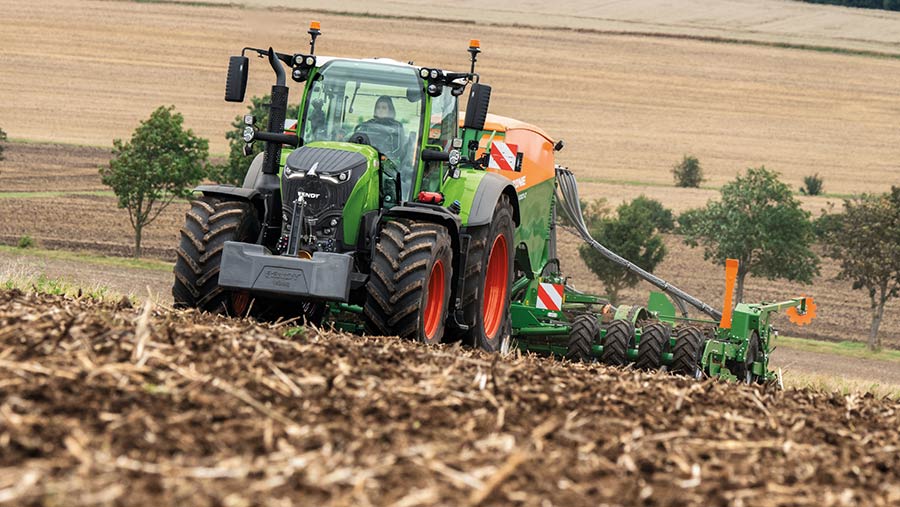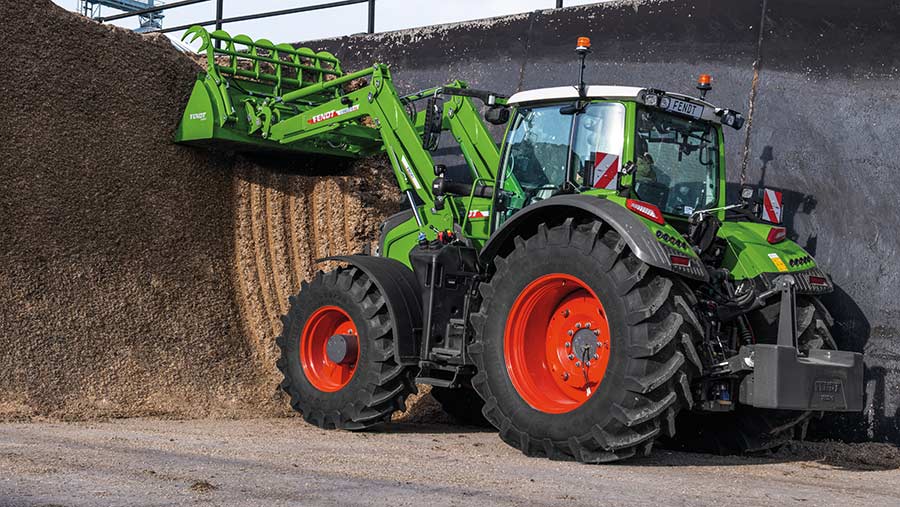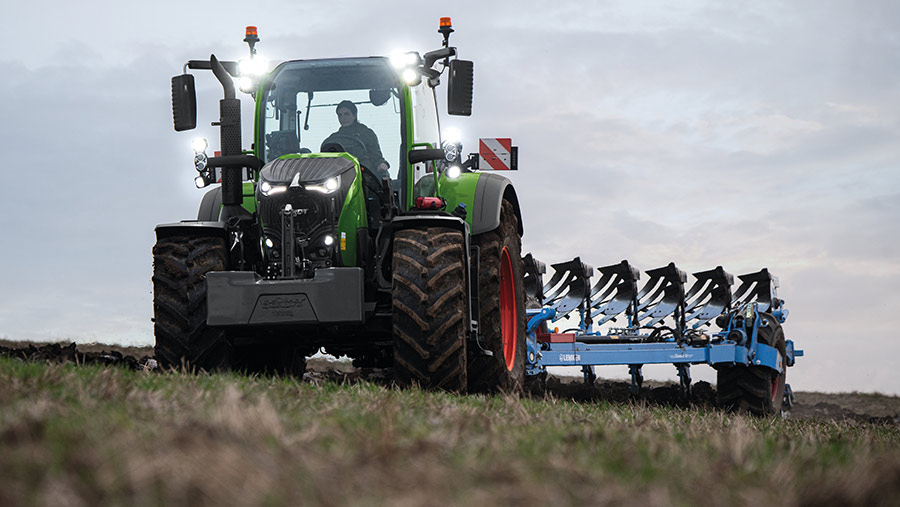New engine and more power for revamped Fendt 700-series
 © Fendt
© Fendt Fendt has unveiled a bigger, more powerful 700-series tractor range that, for the first time, sports an engine from sister brand Agco Power.
It means that the strong-selling 700s – for so long a jewel in the Fendt crown – now stray well into 800-series territory, with the brand-new Agco Power block capable of developing more than 300hp when the apex 728 is boosted to its maximum output.
All five of the so-called Gen7 models, from the 203hp 720 upwards, run a never-seen-before 7.5-litre Agco Power engine with significantly more displacement than the long-serving Deutz unit on the Gen6 versions.
The change of engine and increase in power, lift capacity and maximum payload has necessitated a chassis upgrade, meaning the tractors no longer have the dainty proportions of their predecessors. As a result, the 2.78m wheelbase has been stretched to 2.9m, putting it just 5cm short of the 800 series.
However, Fendt says the 700s still have an appealing power-to-weight ratio of 30.5kg/hp that offers plenty of scope for ballasting for heavy cultivations and drilling, up to a gross weight of 15t.
It remains to be seen how the rest of the line-up will shape up, with the two biggest 700s effectively usurping the 800 series – aside from its ability to offer a reverse drive function.
See also: Ultimate guide to buying a tractor 2022
Range
The existing six Gen6 models – the 714 (150hp), 716 (171hp), 718 (188hp), 720 (209hp), 722 (228hp) and 724 (246hp) – will still be available through dealers for the foreseeable future.
For the Gen7s, the line-up has been slimmed to five, with the lowliest three models discarded and two newcomers – the 726 and 728 – offering 262 and 283hp, respectively.
This means they will overlap heavily with the four 800s (the 822, 824, 826 and popular 828), while the 900s start at the 296hp 930 and extend to the 415hp 942.
On the other side of the 700 sandwich are the 500s that, at present, top out with the 171hp 516. Though it’s pure speculation, there’s now an unmistakable 600-series void in the range…
Engine and transmission
As mentioned, the most significant change is the engine, with the Deutz block finally replaced by something from the Agco Power division.
Surprisingly, it’s not the 7.4-litre six-cylinder that is used in Valtra Q-series and Massey Ferguson 8S tractors of similar power, but rather a 7.5-litre version that – for now, at least – is exclusive to the 700 series.
The 724, Fendt’s biggest seller by some margin, now offers 243hp and 1,220Nm of torque at 1,300rpm. By comparison, its predecessor put out 246hp, but a lesser 1,072Nm at 1,500rpm.
Only the biggest 728 gets a boost function, dubbed “dynamic performance”, that provides an extra 20hp to take output a smidgen north of 300hp, plus 1,450Nm of torque. This isn’t linked to driving speed so is available for static pto work, such as driving a wood chipper.
Emissions are controlled using a diesel oxidation catalyst (DOC), particulate filter and selective catalytic reduction (SCR), but no exhaust gas recirculation.
The driveline features Fendt’s TA190 transmission, which is a new version of the VarioDrive setup seen on the larger 900 and 1000 series. This replaces the ML180 used on the old 700s and is available with a 60kph top speed that, on the 726 and 728, comes at just 1,450rpm. This drops to 1,200rpm at 50kph and a whisper-quiet 950rpm at 40kph.
One improvement likely to be welcomed by owners is the “intelligent all-wheel drive” system, which no longer requires operators to manually switch between field and road modes.
Standard rear tyres on the 726 and 728 are 650/85 R38s, while the three smaller models get 650/65 R42s.
There’s also the option of Fendt’s VarioGrip system to alter pressures on the move, and several driving aids, including a stability control system that reduces sideways lean at speeds above 25kph to minimise roll and improve driving comfort.
Meanwhile, “trailer brake assistant”, like the equivalent system on New Holland and Case IH tractors, uses a sensor to detect when a trailer is pushing the tractor downhill. Should that be the case, the trailer’s pneumatic brakes will automatically engage to reduce the risk of jack-knifing.

© Fendt
Weight, rear lift and hydraulics
Current Gen6 models can be had with a 193 litres/min hydraulic pump, a 10.36t rear lift, and a maximum permissible weight of 14t.
For the new range, those figures rise to 220 litres/min, 11.05t and 15t, which should be a match for the bigger, heavier implements the tractors are likely to carry. Up to five rear spools can be specced, plus two at the front, and three mid-mounts.
There’s also a new Cargo Pro 6,100 loader that has been designed to match the more powerful 700s, which offers a maximum lift capacity of 4,150kg and reach of 4.85m.

© Fendt
Cab
Fendt launched a completely new cab interior for the 700-series two years ago, and it has subsequently been rolled out across the rest of the ranges – with the exception of the 800s.
This brought a fancy new control layout with more processing power, up to three separate touchscreens, and yet more scope for customising the settings.
There has been no change to this offering, so the tractors get the same multifunction joystick, 10in digital dash and a 12in terminal on the armrest as standard, plus an optional third in the roof.
However, it will be possible to upgrade the VisioPlus cab on the Gen7 700s to provided “category 4” protection against dust, aerosols and vapours from the end of 2023, which may well appeal to those using it with a mounted or trailed sprayer. Category 2 (dust) protection is standard.
There is also a new premium seat option, allowing operators to adjust height, position and back angle through the touchscreen terminal. It has climate control, heating and a massage function too, and different drivers can save their specific settings.

© Fendt
When will they be available?
Order books are open now, with the first deliveries expected next spring. These will be available with Fendt’s eight-year/8,000hr warranty, which has proved popular with buyers keen to fix their costs.
The older Gen6 models, from the 714 to the 724, are still being produced.
The Gen7 700 Vario range |
|||||
|
720 |
722 |
724 |
726 |
728 |
|
|
Engine |
Six-cylinder, 7.5-litre Agco Power |
||||
|
Max power (hp) |
203 |
223 |
243 |
262 |
283 / 303 (boosted) |
|
Max torque (Nm) @ 1,300rpm |
1,090 |
1,150 |
1,220 |
1,318 |
1,450 |
|
Transmission |
Vario TA190 |
||||
|
Top speed (kph) |
50 |
60 |
|||
|
Diesel tank (litres) |
450 |
||||
|
AdBlue tank (litres) |
48 |
||||
|
Hydraulics (litres/min) |
165 / 220 (optional) |
||||
|
Spools |
up to 10 |
||||
|
Rear lift capacity (kg) |
11,050 |
||||
|
Front linkage capacity (kg) |
5,300 |
||||
|
Standard tyres (front/rear) |
540/65 R30 / 650/65 R42 |
540/65 R34 / 650/85 R38 |
|||
|
Optional tyres (front/rear) |
600/65 R28 / 710/70 R38 |
600/65 R30 / 710/70 R42 |
|||
|
Wheelbase (mm) |
2,900 |
||||
|
Length (mm) |
3,142 |
3,280 |
|||
|
Operating weight (kg) |
8,800-9,250 |
9,200-9,650 |
|||
|
Max gross weight (kg) |
15,000 |
||||

